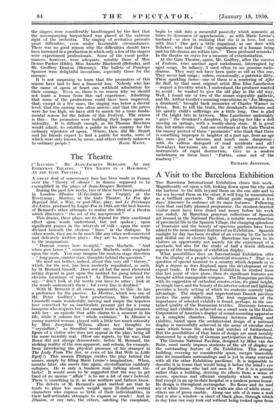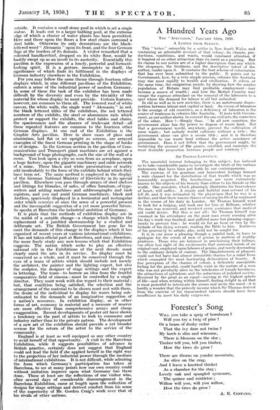A Visit to the Barcelona Exhibition
THE Barcelona International Exhibition closes this week. Magnificently set upon a hill, looking down upon the city and the harbour to the hills beyond them on the one side and to the sea beyond them on the other, it will long be remembered as, a brilliant spectacle. The official guide suggests a five days' itinerary to embrace all its main features. Following even that carefully planned programme, the stoutest-hearted visitor must have been dazed and weary before his week was ended. At Barcelona generous collections of Spanish art housed, in the National Pavilion, a notable reconstruction of provincial life in the Spanish Village, the changing splendour of fountains and the beauty of spacious gardens have been added to the more ordinary features of an Exhibition. Spanish sunlight by day has been rivalled of an evening by the lavish and skilful use of electric light. Barcelona has given to its visitors an opportunity not merely for the enjoyment of a spectacle, but also for the study of half a dozen different aspects of the technique of exhibition display.
What possibilities does an International Exhibition offer for the display of a people's industrial resources ? That is a question of special moment to a country which depends in so high a degree as does England upon the development of its export trade. If the Barcelona Exhibition be studied from this last point of view alone, then its significant features are brought within manageable compass. The Hungarian pavilion with its suggestion of cathedral construction, its giant height, its simple lines, and the beauty of its interior colour and lighting provides a lovely setting of which its contents scarcely take advantage. The shapely and unpretentious Danish pavilion invites the same reflection. The first suggestion of the importance of selected exhibits is found, perhaps, in the sus- tained quality of the Rumanian textiles. Harmony between setting and exhibits is achieved on a small scale in the Radio Corporation of America's display of sound-recording apparatus in. a complete chamber. Harmony between setting and exhibits, based upon the architectural design of a national display is successfully achieved in the array of circular steel cases which house the clocks and watches of Switzerland. But the possibilities of that basis of design are most notably discovered by a study of German participation at Barcelona. The German National Pavilion, designed by Miles van der Rohe, must surely impress students of the art of display as the outstanding feature of the Exhibition. This strange building, covering no considerable space, merges insensibly into its immediate surroundings and is yet in sharp contrast with all the other Exhibition pavilions. It is impossible to describe it in terms that would bring it before the mind's eye of an. Englishman who had not seen it. For it is a gesture rather than a building,, deriving its effects from a sense of severe, . spacious and efficient simplicity which we rarely fwd except in an up-to-date hospital or a modern power house. Its design is throughout rectangular. Its floors and its roof are of white stone.. Some of its walls are also of white stone ; others are of green marble. Along one side of it runs a wall that is also a window—a sheet of black glass, through which• in day time one may look out without being looked upon from outside. It contains a small stone pool in which is set a single statue. It leads out to a larger bathing pool, at the extreme edge of which a cluster of water plants has been permitted. Here and there upon the floors a few steel chairs surround a steel table. Otherwise its only decorations are the black- lettered word " Alemania " upon its front, and the four German flags at the borders of its domain. A visitor remarked that a coloured handkerchief, dropped on its white floor, would be hastily swept up as an insult to its austerity. Essentially this pavilion is the expression of a lonely, powerful and forward- looking spirit. It is a gesture, incomplete in itself, the significance of which finds its fulfilment in the displays of German industry elsewhere in the Exhibition.
For you may follow the same theme through fourteen other displays which, in nine different pavilions of the Exhibition, enforce a sense of the industrial power of modern Germany. In some of these the task of the exhibitor has been made difficult by the diversity and even by the triviality of the material for whose display he must provide. Certain features, however, are common to them all. The lowered roof of white canvas, the white walls, the single word " Alemania " in red, the black lettered titles of the exhibitors, the red lettered numbers of the exhibits, the steel or aluminium rails which protect or support the exhibits, the steel tables and chairs, the spaciousness and the absence of irrelevant detail—all these repeated features are common to the fourteen other German displays. At one end of the Exhibition is the Graphic Arts pavilion. Here in show cases of glass and aluminium, laid flat or set upright as screens, are arrayed examples of the finest German printing in the shape of books or of designs. In the German section in the pavilion of Com- munications and Transport giant machines are set against a background of huge photographs, each the size of the wall of a room. You look upon a city as seen from an aeroplane, upon a huge factory, upon the gigantic machinery and cable network of a mine. Those black and white presentations of reality add incalculably to the force of the exhibits behind which they have been set. The same method is employed in the display of the German National Ministry of Electricity in its special pavilion. Elsewhere you pass through arrays of steel shelves and fittings for libraries, of safes, of office furniture, of type- writers and adding machines and addressographs and cash registers, and you end amid German machinery, black and dustless, spaciously displayed in a horizontal and rectangular order which conveys at once the sense of a powerful present and the inescapable suggestion of a yet more powerful future. So speaks at Barcelona the industrial ambition of Germany.
It is plain that the methods of exhibition display are in the midst of a notable change—a change which implies the replacement of a jumbled showmanship by a studied and deliberate art. The British Government has gone far to meet the demands of this change in the displays which it has organized of recent years at various international exhibitions. It has not taken official part at Barcelona, and may, therefore, the' more freely study any new lessons which that Exhibition suggests. The nation which seeks to play an effective national role in the Exhibitions of the next decade must clearly enrol the arts in its service. Its display must be conceived as a whole, and it must be conceived through the eyes of a team of artists which should include not merely the architect, the painter and the lighting expert, but also the sculptor, the designer of stage settings and the expert in lettering. The team—to borrow an idea from the fruitful comparative field of cinema—must be controlled by a single director. They must work with due regard to their material ; bat, that condition being satisfied, the selection and the arrangement of the material to be shown must rest with them, the desire of the individual to display his wares being sub- ordinated to the demands of an imaginative suggestion of a nation's resources. In exhibition display, as in other forms of art, economy in material and a measure of reserve are more effective than comprehensive arrays and cheap exaggeration. Recent developments of poster art have shown a tendency on the part of artists to look to conunerce and industry rather than to the private patron. The development of a new art of the exhibition should provide a yet' broader avenue for the return of the artist to the service of the community. England is at least as well equipped as any other country to avail herself of that opportunity. A visit to the Barcelona Exhibition, while it suggests possibilities of advance in British practice, certainly does not suggest that England could not lead the field if she applied herself m the right way to the projection. of her industrial power through the medium of international exhibitions. It is not difficult, while admiring the form which Germany's participation has taken at Barcelona, to see at many points how our own country could without imitation improve upon what Germany -has there done.. These at least are the reflections of one visitor who, after several days of considerable discouragement in the Barcelona Exhibition, came at length upon the collection of designs for 'stage settings and derived comfort from his sense of the superiority of Mr. Gordon Craig's work- over that of
his• rivals, of other nations. •







































 Previous page
Previous page